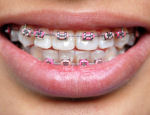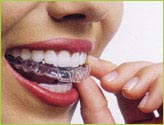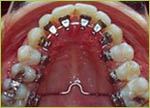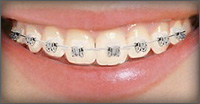
Types of Dental Braces
Until some years ago, the only option for those who needed orthodontic treatment was the traditional grey metal braces. Today, several different types of orthodontic braces are available for the correction of malocclusion problems. All types of orthodontic braces are designed to enable the orthodontist to move teeth in three dimensions.
Patients can choose between classic stainless steel or gold (metal braces), ceramic or plastic (clear braces), or more modern braces systems (lingual braces, Invisalign, Damon brackets).
The Different Types of Orthodontic Braces
The types of dental braces that orthodontists use for straightening teeth include:
 Stainless steel metal braces – (usually made in combination with nickel titanium) are the most widely used type of dental braces.
Generally these traditional metal braces are the most economic option if you are looking for cheap braces. However the steel metal braces can sometimes cause staining of the surface of the teeth.
They should not be used by those who are allergic to nickel.
Stainless steel metal braces – (usually made in combination with nickel titanium) are the most widely used type of dental braces.
Generally these traditional metal braces are the most economic option if you are looking for cheap braces. However the steel metal braces can sometimes cause staining of the surface of the teeth.
They should not be used by those who are allergic to nickel. Gold Braces - gold-plated braces in combination with gold arch-wires are mostly chosen for their aesthetic appeal as they blend better with teeth. They also provide an alternative for patients allergic to nickel.
Gold Braces - gold-plated braces in combination with gold arch-wires are mostly chosen for their aesthetic appeal as they blend better with teeth. They also provide an alternative for patients allergic to nickel.
 Ceramic braces – also known as clear braces they are made of a glass-like composite material and they are less noticeable than metal braces.
Theis type of dental braces is suitable for patients concerned about their appearance, as the ceramic brackets are translucent blending with the natural tooth color, but they are much more expensive.
However, ceramic brackets are also more brittle and prone to breakage, so they are not recommended for cases that require large pressures to move teeth.
Ceramic braces – also known as clear braces they are made of a glass-like composite material and they are less noticeable than metal braces.
Theis type of dental braces is suitable for patients concerned about their appearance, as the ceramic brackets are translucent blending with the natural tooth color, but they are much more expensive.
However, ceramic brackets are also more brittle and prone to breakage, so they are not recommended for cases that require large pressures to move teeth. Invisalign – The Invisalign system uses a series of clear plastic custom-made trays to move teeth into their position.
Actually, Invisalign appliances aren’t braces at all, because there are no brackets bonded to the teeth, and no wires.
Instead of adjusting the arch-wires like in traditional braces, the Invisalign system requires a new teeth aligner tray every two weeks.
Each teeth aligner is individually manufactured with exact computed calculations to gradually shift the teeth into their final position.
Invisalign – The Invisalign system uses a series of clear plastic custom-made trays to move teeth into their position.
Actually, Invisalign appliances aren’t braces at all, because there are no brackets bonded to the teeth, and no wires.
Instead of adjusting the arch-wires like in traditional braces, the Invisalign system requires a new teeth aligner tray every two weeks.
Each teeth aligner is individually manufactured with exact computed calculations to gradually shift the teeth into their final position.
Invisalign system braces are ideal for those who have slight orthodontic problems, as they are almost invisible and much less noticeable than classic metal braces. They are not recommended for severe malocclusions. Invisalign braces cause less problems with staining and mouth sores, and also help to maintain good oral hygiene as they can be removed easily during eating or brushing.
Read more about Invisalign
 Lingual braces - Lingual (hidden) braces are a special type of orthodontic braces fitted to the back surfaces of the teeth.
They look like traditional metal braces with wires but they are not that visible from the front.As they are not easily noticed by others, lingual braces are also referred as ‘hidden braces’.
Lingual braces - Lingual (hidden) braces are a special type of orthodontic braces fitted to the back surfaces of the teeth.
They look like traditional metal braces with wires but they are not that visible from the front.As they are not easily noticed by others, lingual braces are also referred as ‘hidden braces’.
However because of their placement in the inner side of teeth, the lingual dental braces come constantly in contact with the tongue, which could become uncomfortable, cause severe sores or cuts to the tongue, and cause difficulties in speech. Lingual dental braces are more expensive than traditional metal braces and require a specially trained orthodontist to the specific type of braces.
 Damon Brackets - Damon braces are based on one of the modern technologies in orthodontics called ‘self-ligation’. For this reason they are also referred as ‘Self Ligating Braces’.
Unlike classic braces, Damon brackets do not require ligatures or small bands that are usually used to keep the arch-wires in place. They offer a lower-friction solution to teeth straightening.
The Damon brackets use a "sliding-door" technology that allows the wire to slide back and forth inside the bracket causing less friction.
Therefore they are considered as more comfortable for the patient than the other types of dental braces. Also, Damon brackets offer faster orthodontic treatment time and smaller number of adjustments.
Damon Brackets - Damon braces are based on one of the modern technologies in orthodontics called ‘self-ligation’. For this reason they are also referred as ‘Self Ligating Braces’.
Unlike classic braces, Damon brackets do not require ligatures or small bands that are usually used to keep the arch-wires in place. They offer a lower-friction solution to teeth straightening.
The Damon brackets use a "sliding-door" technology that allows the wire to slide back and forth inside the bracket causing less friction.
Therefore they are considered as more comfortable for the patient than the other types of dental braces. Also, Damon brackets offer faster orthodontic treatment time and smaller number of adjustments.
Which type of braces should I choose?
After the orthodontic evaluation, the orthodontist will advise the patient on the possible treatment options for each individual’s needs. The severity of the malocclusion, expected treatment time and cost of treatment are the most important factors for deciding the type of dental braces to be used. Severe malocclusion problems may not be treated with Invisalign or ceramic braces. Other patients concerned about their appearance during treatment may prefer the less noticeable types of dental braces such as Invisalign, lingual braces or ceramic braces despite their higher cost.
Colored Braces
Until some years ago, metal braces were only available in one color and one shape. Gray colored and square shaped dental braces were the only option for orthodontic treatment. A lot of teenagers are concerned about their appearance when they will have to wear braces. Even though the orthodontic treatment will give them a beautiful smile for the rest of their life, they are hesitant to start wearing braces due to the possible negative comments about their look. Solutions offered by modern orthodontics include ‘clear’ ceramic braces and Invisalign, which are much less noticeable than metal braces, but they very expensive and many families may not afford the cost of treatment.
 Another solution appeared recently with the addition of color into braces and quickly became a fashion among teenagers.
Now, the metal brackets can be in a variety of colors and shapes. You can choose blue star shaped brackets instead of the classic grey square ones.
Another solution appeared recently with the addition of color into braces and quickly became a fashion among teenagers.
Now, the metal brackets can be in a variety of colors and shapes. You can choose blue star shaped brackets instead of the classic grey square ones.
 Even if the lower cost classic grey metal braces are used, a spice of color can be added by using colored elastics.
Elastics are available in many different colors. They can be regularly changed, which means teenagers can pick out different colors every time they visit the orthodontist for adjustments.
Colored elastics can be used also with ‘clear’ ceramic braces if the kid prefers the colorful and more ‘fashionable’ look of colored braces.
Even if the lower cost classic grey metal braces are used, a spice of color can be added by using colored elastics.
Elastics are available in many different colors. They can be regularly changed, which means teenagers can pick out different colors every time they visit the orthodontist for adjustments.
Colored elastics can be used also with ‘clear’ ceramic braces if the kid prefers the colorful and more ‘fashionable’ look of colored braces.
![]() The cost of orthodontic treatment can be significant and many patients may not afford it if they are not covered by their dental insurance.
Learn how to choose a dental insurance plan that will provide the best dental treatment to you and your family.
The cost of orthodontic treatment can be significant and many patients may not afford it if they are not covered by their dental insurance.
Learn how to choose a dental insurance plan that will provide the best dental treatment to you and your family.

